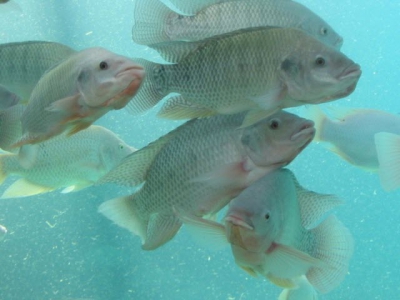New study sheds light on how tilapia lake virus is spread

A new study suggests that tilapia lake virus can be transmitted from parents to offspring.
A new study in the Journal of Fish Diseases has identified instances where tilapia infected with tilapia lake virus (TiLV) passed the disease onto their offspring without cohabitating. This finding suggests that the virus can be transmitted vertically, as well as through the cohabitation of infected and susceptible fish.
Tilapia lake virus is a viral disease that infects tilapia globally. The disease causes skin lesions and ulcers, eye abnormalities, reduced schooling behaviour and mass mortalities. Tilapia that have been infected with the virus but survive are immune from further TiLV infections. As it stands now, there is no treatment or vaccine for the disease, but this may change in the future.
In this study, researchers were able to isolate TiLV RNA in the liver and gonads of broodstock males and females. Infective virus was isolated in the cell line. When testing two-day-old fry for the presence of TiLV, results indicated that they had inherited the virus from broodstock.
In light of these results, the researchers emphasised the need to adhere to strong biosecurity measures. By prioritising prevention and ensuring that the virus does not get introduced to the farm site, the disease will not proliferate. The researchers also suggested that TiLV-free broodstock be developed in order to limit vertical transmission.
Evidence of potential vertical transmission of tilapia lake virus
Tilapia lake virus disease (TiLVD) is an emerging viral disease in tilapia with worldwide distribution. Although the horizontal transmission of TiLV has been demonstrated through the cohabitation of infected fish with susceptible fish, no direct experiment showed the potential of vertical transmission from broodstock to progeny.
In this study, natural outbreaks of TiLV in broodstock and fry in two tilapia hatcheries were confirmed. The TiLV genomic RNA was detected in liver and reproductive organs of infected broodstock, while infective virus was isolated in susceptible cell line.
In situ hybridization assay confirmed the presence of TiLV in the ovary and testis of naturally infected fish and experimentally challenged fish. Moreover, early detection of TiLV in 2‐day‐old fry and the presence of TiLV genomic RNA and viable virus in the testis and ovary suggested the possible transfer of this virus from infected broodstock to progenies.
As infective virus was present in gonads and fry in natural outbreak and experimental fish, the importance of biosecurity and prevention of the virus to establish in the hatchery should be emphasized. Hence, the development of TiLV‐free broodstock and the maintenance of high biosecurity standards in the hatcheries are essential for any attempt of virus eradication.
Related news
 Probiotic gives growth, immune response in farmed carp
Probiotic gives growth, immune response in farmed carp Supplementing carp diets with B. subtilis may improve fish growth performance and support fish health and intestinal antioxidant capacity while reducing
 Zinc, omega-3 fatty acids influence salmon health
Zinc, omega-3 fatty acids influence salmon health Nutrients provide important interaction in barrier tissues of salmon intestines and gills, with implications for recirculating systems and aquaculture.
 Research targets domestic production of marine fish
Research targets domestic production of marine fish While the U.S. has the capacity to meet domestic demand for seafood by expanding aquaculture in federal waters and land-based recirculating systems